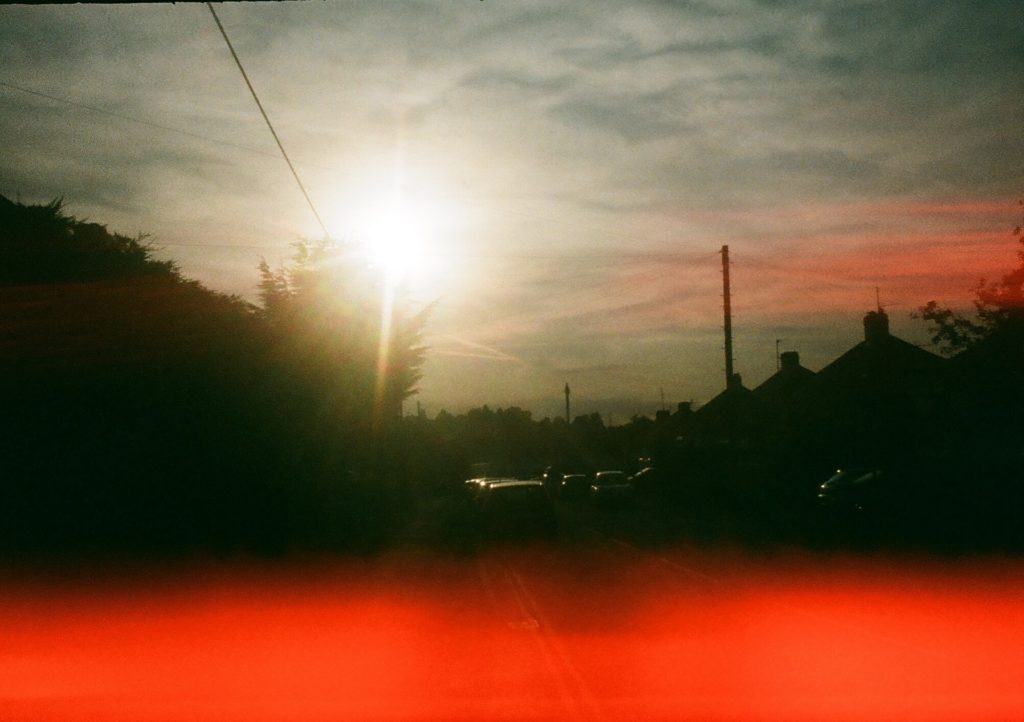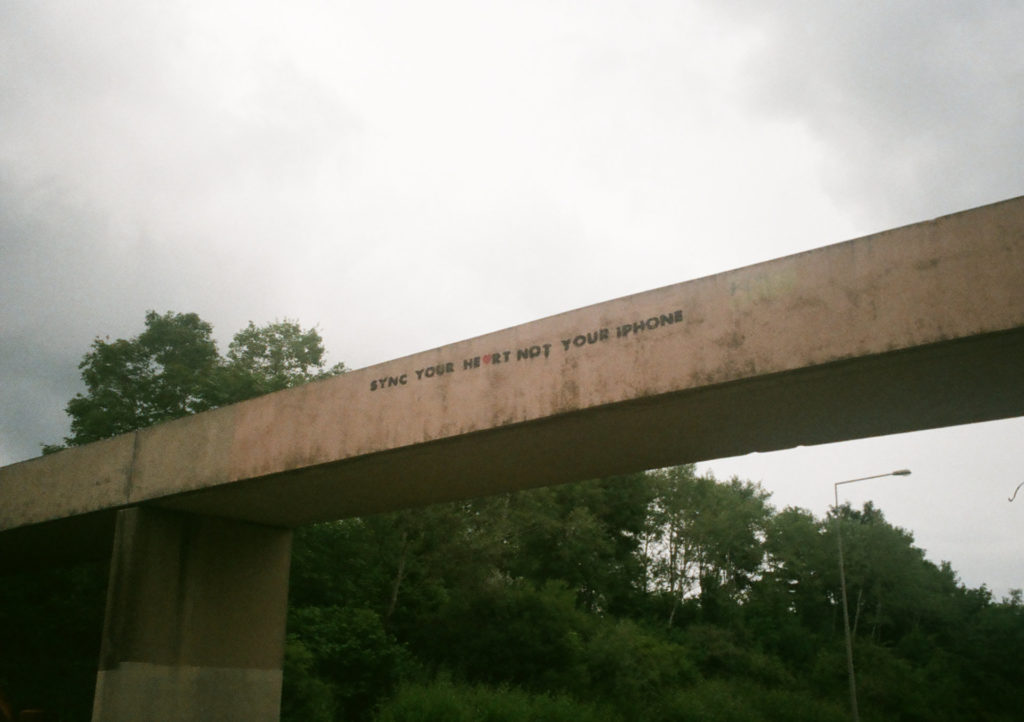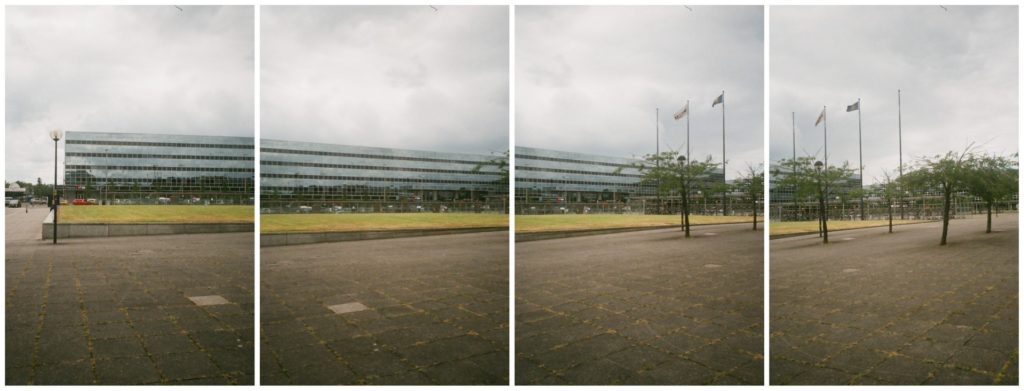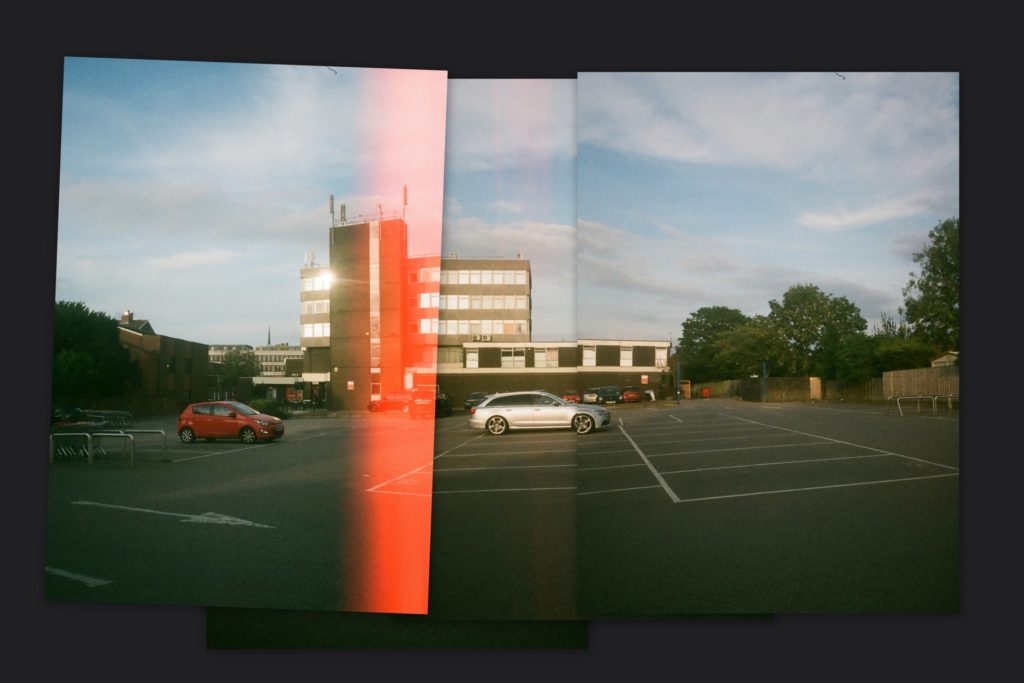Because my last video on the Fuji TW-3 was quite popular, I made another video to show you a bit more about the camera, including how to load a film into it and how to protect it from light-leaks too.
I chose one of my films from my fantastic stash of 24 exposure films. I think it would be interesting to go through all of these films some time, but I don’t have time right now. But what we’re using today is this roll of Agfa HDC Plus, which the box tells us expired in May 2001.
Now I’m guessing the name TW-3 stands for “telephoto-wide” and you will have seen in the previous video that the camera has two lenses which sit opposite each other underneath this rotating plate, and you switch it on by rotating it to select one of the two modes.
So in one position it’s in the telephoto mode and when it’s in the wide angle mode it needs a flash, so when you swing that lens into place the flash pops up.
You can do a little bit of focusing. You can select three zones with a switch on the right hand side; a four meter zone, a six meter zone and a 12 meter or infinity zone.
When you switch it off you can pop the flash back down, and on the left hand side this switch is momentary and I think that allows you to go down to half a meter or 50 centimeters for really close up stuff.
On the top you’ve got the button for shutter, and a little continuous shooting mode option, and you will see it says “Fuji TW-3 pre winding” which we’ll chat more about shortly.
On the top is also the indicator for how many pictures you have taken, and some sort of red light that I don’t really know the function of right now and on the front it has the logo that says it uses DX coding as well.
Now as regards the Agfa HDC plus film, I got this from a photographic shop in America several years ago and as I discussed it expired in May 2001 so that makes it over 19 years old!
Loading it into the Fuji, there’s a little switch on the back and when you pop that open the whole back of the camera swings out. You slot the film canister in so that it loads the film vertically, and so you just tuck the leader down there near the little sign that says “film” (meaning “get your film in there!”). There’s also a roller that is slightly sticky, which I think is deliberately self-adhesive but you never know with old cameras whether the rubber has degraded when something is sticky.
When you close up the camera you should get at least 30 seconds of winding noise!
What that’s done is it’s pulled all the film out of the canister and rolled it all up onto the take-up spool inside the camera, ready to to start shooting
This means when you get to the end of the film it’s ready to be taken out, and there’s no need to rewind the film before you open the camera.
Now as I mentioned if you’ve seen my previous video about this camera, this particular example has one real sad thing which is it is a very leaky camera. It has a lot of gaps and we need to make sure that light doesn’t leak into the camera through them, in particular because all of the film is now wound out of the canister which protects it.
In that video we discussed how the light leaks that this camera suffers from just look really bad. They don’t look cool at all.
One of the features the TW-3 has is a little window which not only tells you that there is a film in the camera but also what the actual brand of film is. But I think that window is also the source of a light leak, as the seal around it has broken down over the years.
Similarly the clasp and both the hinge and everywhere where the door can open is also susceptible to light leaks.
So these have all got to be sealed up and what we do that with is good old black electrical tape, which you can get from DIY stores like the kind of places that sell electrical items like plugs and wire and screwdrivers.
The tape does come in other colors but black really keeps out loads of unwanted light and you do want this stuff, the electrical tape, because it’s soft and it’s easy to use and if you don’t leave it on too long it doesn’t leave a sticky residue on your camera like some other types of tape can.
So what we want is a little bit to cover the window. It doesn’t matter that we can’t use the window anymore because we know there is a film in it and it’s far more important that we keep the light out. I also cut a length of tape to cover the hinge.
So like I mentioned about this tape it’s kind of soft and it goes-where-you-want-it-to-go, so when I needed it to go all along the hinge it was being very…agreeable. I needed to pinch it together when it comes around the curvy bits of the camera and honestly it just works, it really does.
You could say it’s a shame to be so brutal with how much tape I’m using to cover bits of the camera, but I really do like this camera when it isn’t leaky, and so it benefits in the end from all the effort.
Now I loaded the camera with film in early February 2020, but sadly with this being late March 2020 as I write this the Coronavirus has hit the UK pretty hard and getting out and about for photography has suddenly had to stop.
I ’ve had the camera with me whilst I have been at work and have shot a lot of images with it, but the chances of me finishing the film and posting it off for development are a bit slimmer now that the UK is well and truly practicing social distancing.
’ve had the camera with me whilst I have been at work and have shot a lot of images with it, but the chances of me finishing the film and posting it off for development are a bit slimmer now that the UK is well and truly practicing social distancing.
But to make the most of the effort I made for the video so far it seemed a good idea to go back over some of the images I have shot with this camera and chat through those with you.
When we do get through everything the Coronavirus is putting us through I can share the images on the Agfa film with you if they are worth sharing, but until then, let’s take a look at a few images from the past.
So I got the Fuji on a trip to Japan which I made in April and May of 2014 and I’m fairly certain that I got the camera in a shop called “Lucky Camera” which is in Tokyo.
Honestly it’s six years ago now so I don’t have a full recollection of exactly when it was but I’m fairly certain it was there, because I bought some film in some big department stores in Japan like Yodabashi but we only went to the one dedicated camera store and remember I bought a 28 millimeter lens for my Olympus OM10 and I also bought the Fuji TW-3.
But I didn’t use it in Japan for whatever reason and instead I waited until I got back to the UK, and this is the first picture that I took after I’d loaded it with some Agfa Vista 200.
This picture is taken in what was called “the room of doom” in the house in Oxford that I lived in; at the time it was at my art studio and where I did my creative stuff and it was always pretty chaotic compared to the rest of my house.
This picture stands out in no shape or form except that it was the first picture that I took with the Fuji TW-3. It looks like the flash was on, but I have no idea what time of day or night it was; it’s simply the first picture that I took.
 Moving on, I took the camera with me on a cycling trip to Milton Keynes, so I’d actually driven there from Oxford with my bike in the car. I had gone for a ride in Milton Keynes and I was using the TW-3 to take pictures whilst I was out and about.
Moving on, I took the camera with me on a cycling trip to Milton Keynes, so I’d actually driven there from Oxford with my bike in the car. I had gone for a ride in Milton Keynes and I was using the TW-3 to take pictures whilst I was out and about.
So this is some of the classic modern housing from Milton Keynes. If you don’t know Milton Keynes, it’s a modern, planned city in the UK. It was developed in the 1960s and 70s so lots of the architecture is very “of-that-time”.
 If you’re from or familiar with the UK then this sign of the white disc with the black diagonal means that the national speed limit applies and somebody has graffitied this smiley face onto this particular one.
If you’re from or familiar with the UK then this sign of the white disc with the black diagonal means that the national speed limit applies and somebody has graffitied this smiley face onto this particular one.
But this picture and this picture were taken at exactly the same point and they show me testing the wide angle and the telephoto version of the le ns.
ns.
Again, I was just riding around, just looking about, seeing what-was-what and looking for anything that took my fancy because I’d got a half frame camera and even with a 24 exposure roll I was going to get 48 half frame shots to play with, so I didn’t have to particularly worry about what I was shooting.
But I do remember that I saw this particular phrase written on the side of this bridge and it really stuck with me; “sync your heart not your iPhone”. It was a very thoughtful piece of graffiti that really pertains to the modern age in which we live and I was glad I was able to get a picture of that while I was there.
This picture…well this picture is so wrong in so many ways and yet it’s kind of brilliant because there are all sorts o f converging verticals and horizontals and that picture should be a lot straighter.
f converging verticals and horizontals and that picture should be a lot straighter.
I was obviously standing on the wonk, but I probably had my bike with me as well, so what can I say…you’re out and about taking pictures left, right and centre with a little pocket snappy camera. This is not Ansel Adams time.
 This is a pretty good example of if you’ve never been to Milton Keynes of how unique it is compared to your average old-school town in the UK. They have these little places where you can get from one side of the road to the other, like road crossings but if you’re walking as a pedestrian you don’t have to get wet whilst you wait for a break in the traffic. This one’s been quite brightly decorated although the shot, again, is rather wonky.
This is a pretty good example of if you’ve never been to Milton Keynes of how unique it is compared to your average old-school town in the UK. They have these little places where you can get from one side of the road to the other, like road crossings but if you’re walking as a pedestrian you don’t have to get wet whilst you wait for a break in the traffic. This one’s been quite brightly decorated although the shot, again, is rather wonky.
I also did some collages on that trip, so this one is of the front of the Network Rail buildings in Milton Keynes, although looking at the number of pictures that I took I don’t know what I was doing with the camera other than seemingly waving it backwards and forwards quite madly!
This one is a bit more logical, I seem to recall I used the continuous shooting feature on this one and that’s more of whatever a four panel version of a diptych or a triptych is called.
I took most of that first roll on a on a rainy day so I never really got to see what the camera could do with bright sunshine, but I know that the next film that I put in it was a roll of Ilford XP2 and I took the camera on a trip later that year to Snowdonia in North Wales, because my cousin and I decided to climb Mount Snowdon.
 I remember at the time that I was disappointed with these pictures as they didn’t seem to have black backs and white whites and they looked very patchy, and I was convinced that the photo processor had done a bad job of processing them, to the extent that I scanned some of them again myself…and I realized when I did that there was nothing wrong with what the photo processor had done, and it was that the film didn’t seem to work well in this camera.
I remember at the time that I was disappointed with these pictures as they didn’t seem to have black backs and white whites and they looked very patchy, and I was convinced that the photo processor had done a bad job of processing them, to the extent that I scanned some of them again myself…and I realized when I did that there was nothing wrong with what the photo processor had done, and it was that the film didn’t seem to work well in this camera.
Having had more experience of both the film and the camera I’m fairly certain you need a lot of light for the chromogenic films. They don’t perform well in subdued light and you certainly need a lot of light for this little half frame camera.
 But on reflection now, 5 and a bit years on, I don’t know what all the fuss was about!
But on reflection now, 5 and a bit years on, I don’t know what all the fuss was about!
They look ok and certainly having climbed several of these types of mountains since I took these photos they do a good job of what being on a misty mountain in in the United Kingdom is like for sure.
Whilst we were in North Wales we also went to a place called place called Borth Y Gest on the North Wales Coast where I went on holiday when I was about 10 years old. I’d never been back there in all that time and I took a bunch of pictures.
 Looking back at them…I mean this one of the sea rippling from the top of the cliff is actually pretty good, and this one of the beach at Borth is really nice-looking, so I don’t know what my problem with it all was.
Looking back at them…I mean this one of the sea rippling from the top of the cliff is actually pretty good, and this one of the beach at Borth is really nice-looking, so I don’t know what my problem with it all was.
This one of the garages is equally awesome too. I mean it’s not a sharp lens and it’s not a refined camera, but this is the kind of picture that, were it to be part of what you call the “plates”, you know the photographs in the centre of a book by somebody, well I think these images wouldn’t be out of place.
 They have a certain aesthetic for me, but I find it’s difficult to talk about this style “post-Instagram”.
They have a certain aesthetic for me, but I find it’s difficult to talk about this style “post-Instagram”.
I think that Instagram, coming out of the ubiquity of the mobile phone camera and the ability to dial up and look at an image from just about anywhere in the world, any time you want has meant that the experience of looking through books and magazines and seeing a corner of the world where you might never get to has changed.
I’ m not saying it’s diluted anything, it’s no different to magazines being new in the age of oil paintings and frescoes, but this picture at the garage has it’s own mystique and exoticism to me if I think of that idea of “learning about the world from far away” through books, but it would get lost in the huge world of Instagram.
m not saying it’s diluted anything, it’s no different to magazines being new in the age of oil paintings and frescoes, but this picture at the garage has it’s own mystique and exoticism to me if I think of that idea of “learning about the world from far away” through books, but it would get lost in the huge world of Instagram.
I definitely like this one of the palm trees.
I did a couple of photomontages on this trip too, this one is taken up Mount Snowdon, part way up the mountain, and actually I mean I think that’s pretty good. 
This one is a collage from Borth y Gest which is pretty epic. The only problem with all of these colleges is it’s not actually very easy to see them on-screen because they’re so wide, but actually looking back on that it’s very nice.
I don’t really know why I was so snobbish about this roll of film back then, but…I was. Just goes to show what some perspective can do.
 So those pictures were all from 2014 and about a year later I took some more pictures with it in 2015 and things were not so good by that time, something had happened to let the light start leaking in.
So those pictures were all from 2014 and about a year later I took some more pictures with it in 2015 and things were not so good by that time, something had happened to let the light start leaking in.
So you can see here the red, the dreaded red leaking in. These are not good pictures to me, they’re not so cool they’re really not.
I did do this photomontage within the leaky period in 2015 and this one’s simply worth mentioning because that is West way house in Botley, which is no longer there. New buildings are now being built on top of it so that has some historical curiosity, and there may be that light leak but it doesn’t look too bad in the context I guess.
Anyway there’s a selection of pictures from the Fuji TW-3. Like I say, the Coronavirus is keeping us indoors and it means I’m not going to be able to finish and develop the current roll for a while, so I hope that what you have seen has been interesting for a variety of the types of pictures that the camera can take, from both color and black-and-white film.
